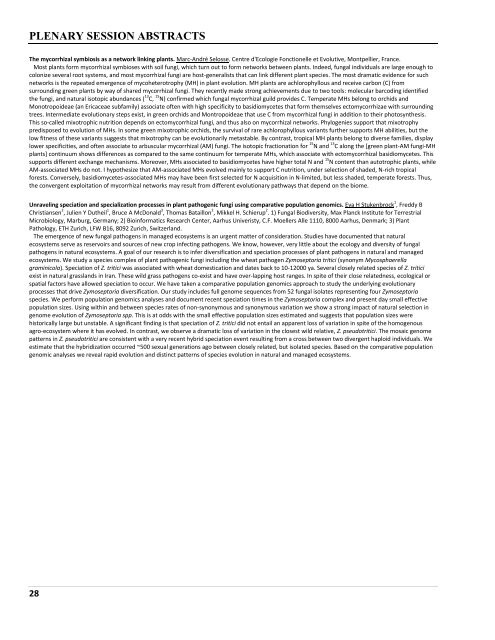Program Book - 27th Fungal Genetics Conference
Program Book - 27th Fungal Genetics Conference
Program Book - 27th Fungal Genetics Conference
You also want an ePaper? Increase the reach of your titles
YUMPU automatically turns print PDFs into web optimized ePapers that Google loves.
PLENARY SESSION ABSTRACTSThe mycorrhizal symbiosis as a network linking plants. Marc-André Selosse. Centre d'Ecologie Fonctionelle et Evolutive, Montpellier, France.Most plants form mycorrhizal symbioses with soil fungi, which turn out to form networks between plants. Indeed, fungal individuals are large enough tocolonize several root systems, and most mycorrhizal fungi are host-generalists that can link different plant species. The most dramatic evidence for suchnetworks is the repeated emergence of mycoheterotrophy (MH) in plant evolution. MH plants are achlorophyllous and receive carbon (C) fromsurrounding green plants by way of shared mycorrhizal fungi. They recently made strong achievements due to two tools: molecular barcoding identifiedthe fungi, and natural isotopic abundances ( 13 C, 15 N) confirmed which fungal mycorrhizal guild provides C. Temperate MHs belong to orchids andMonotropoideae (an Ericaceae subfamily) associate often with high specificity to basidiomycetes that form themselves ectomycorrhizae with surroundingtrees. Intermediate evolutionary steps exist, in green orchids and Montropoideae that use C from mycorrhizal fungi in addition to their photosynthesis.This so-called mixotrophic nutrition depends on ectomycorrhizal fungi, and thus also on mycorrhizal networks. Phylogenies support that mixotrophypredisposed to evolution of MHs. In some green mixotrophic orchids, the survival of rare achlorophyllous variants further supports MH abilities, but thelow fitness of these variants suggests that mixotrophy can be evolutionarily metastable. By contrast, tropical MH plants belong to diverse families, displaylower specificities, and often associate to arbuscular mycorrhizal (AM) fungi. The isotopic fractionation for 15 N and 13 C along the [green plant-AM fungi-MHplants] continuum shows differences as compared to the same continuum for temperate MHs, which associate with ectomycorrhizal basidiomycetes. Thissupports different exchange mechanisms. Moreover, MHs associated to basidiomycetes have higher total N and 15 N content than autotrophic plants, whileAM-associated MHs do not. I hypothesize that AM-associated MHs evolved mainly to support C nutrition, under selection of shaded, N-rich tropicalforests. Conversely, basidiomycetes-associated MHs may have been first selected for N acquisition in N-limited, but less shaded, temperate forests. Thus,the convergent exploitation of mycorrhizal networks may result from different evolutionary pathways that depend on the biome.Unraveling speciation and specialization processes in plant pathogenic fungi using comparative population genomics. Eva H Stukenbrock 1 , Freddy BChristiansen 2 , Julien Y Dutheil 1 , Bruce A McDonald 3 , Thomas Bataillon 2 , Mikkel H. Schierup 2 . 1) <strong>Fungal</strong> Biodiversity, Max Planck Institute for TerrestrialMicrobiology, Marburg, Germany; 2) Bioinformatics Research Center, Aarhus Univeristy, C.F. Moellers Alle 1110, 8000 Aarhus, Denmark; 3) PlantPathology, ETH Zurich, LFW B16, 8092 Zurich, Switzerland.The emergence of new fungal pathogens in managed ecosystems is an urgent matter of consideration. Studies have documented that naturalecosystems serve as reservoirs and sources of new crop infecting pathogens. We know, however, very little about the ecology and diversity of fungalpathogens in natural ecosystems. A goal of our research is to infer diversification and speciation processes of plant pathogens in natural and managedecosystems. We study a species complex of plant pathogenic fungi including the wheat pathogen Zymoseptoria tritici (synonym Mycosphaerellagraminicola). Speciation of Z. tritici was associated with wheat domestication and dates back to 10-12000 ya. Several closely related species of Z. triticiexist in natural grasslands in Iran. These wild grass pathogens co-exist and have over-lapping host ranges. In spite of their close relatedness, ecological orspatial factors have allowed speciation to occur. We have taken a comparative population genomics approach to study the underlying evolutionaryprocesses that drive Zymoseptoria diversification. Our study includes full genome sequences from 52 fungal isolates representing four Zymoseptoriaspecies. We perform population genomics analyses and document recent speciation times in the Zymoseptoria complex and present day small effectivepopulation sizes. Using within and between species rates of non-synonymous and synonymous variation we show a strong impact of natural selection ingenome evolution of Zymoseptoria spp. This is at odds with the small effective population sizes estimated and suggests that population sizes werehistorically large but unstable. A significant finding is that speciation of Z. tritici did not entail an apparent loss of variation in spite of the homogenousagro-ecosystem where it has evolved. In contrast, we observe a dramatic loss of variation in the closest wild relative, Z. pseudotritici. The mosaic genomepatterns in Z. pseudotritici are consistent with a very recent hybrid speciation event resulting from a cross between two divergent haploid individuals. Weestimate that the hybridization occurred ~500 sexual generations ago between closely related, but isolated species. Based on the comparative populationgenomic analyses we reveal rapid evolution and distinct patterns of species evolution in natural and managed ecosystems.28











